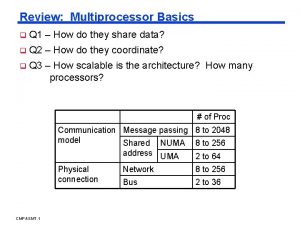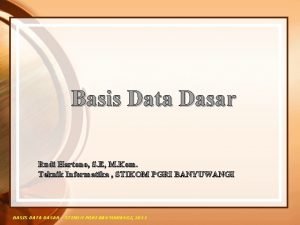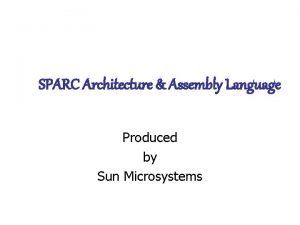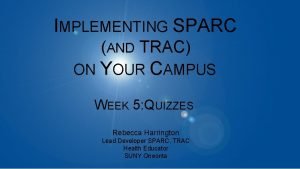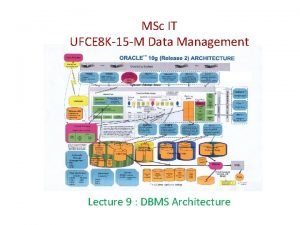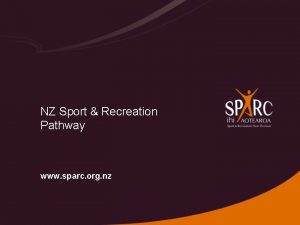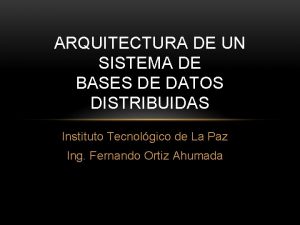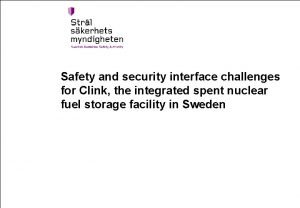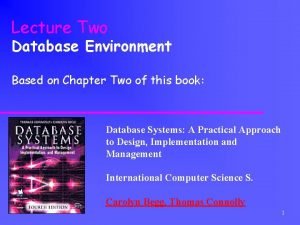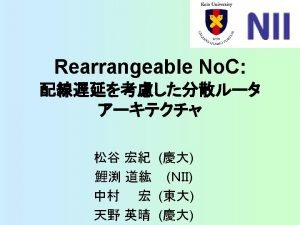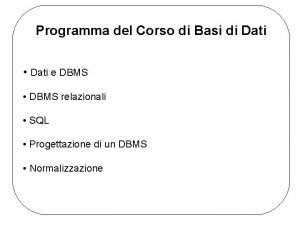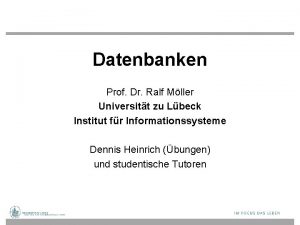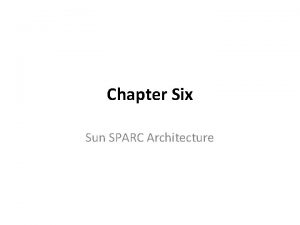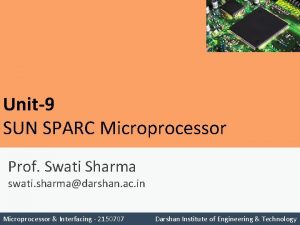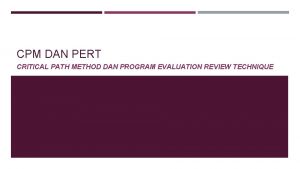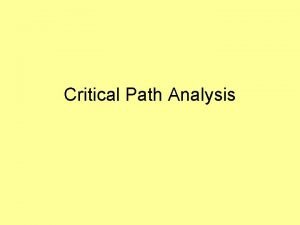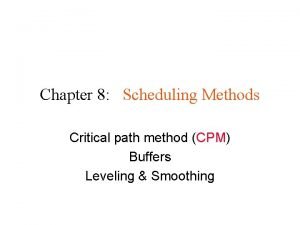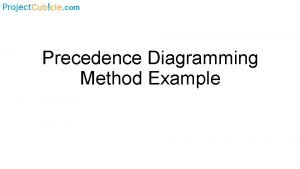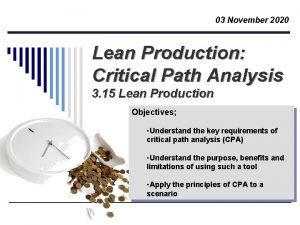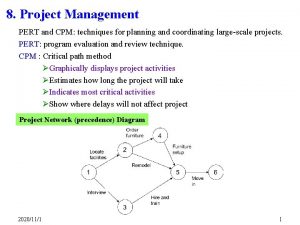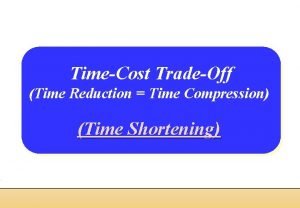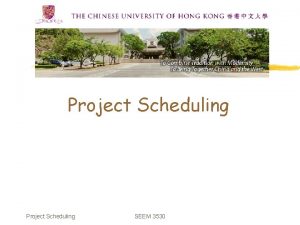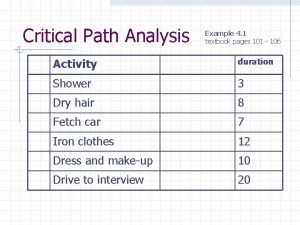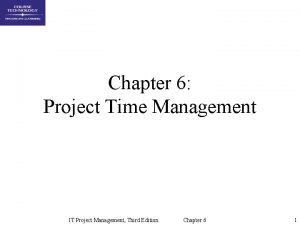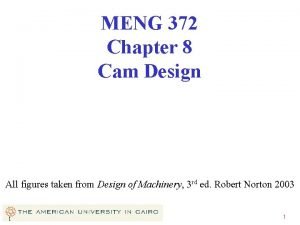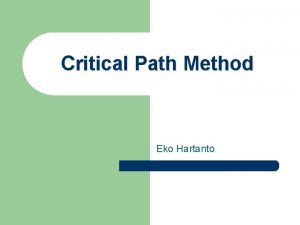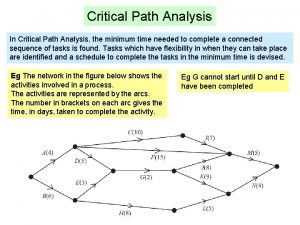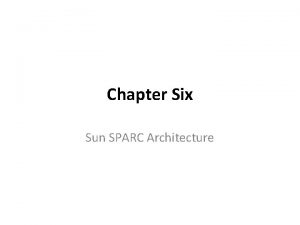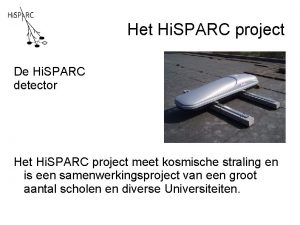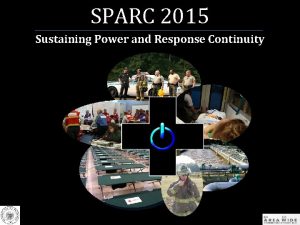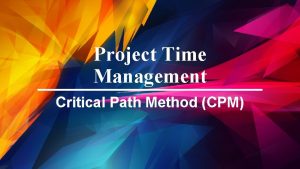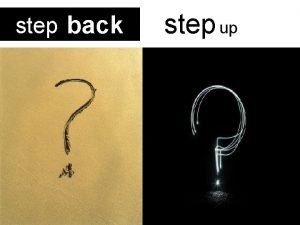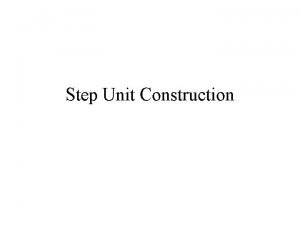SPARC A Critical Step On The HighMagneticField Path



































- Slides: 35

SPARC: A Critical Step On The High-Magnetic-Field Path To Practical Fusion Energy MIT & CFS Teams: Presented by Martin Greenwald April 12, 2018 For NAS Panel: Strategic Plan for U. S. Burning Plasma

Acknowledgements Many contributions, particularly from – Joe Minervini & PSFC Magnet Group – Dan Brunner* – Zach Hartwig – Earl Marmar – Bob Mumgaard* – Brandon Sorbom* – Dennis Whyte * Commonwealth Fusion Systems – who will be funding the project described here 4/12/2018 NAS Panel: SPARC 2

The Need For Fusion Is Clear – The World Needs Reliable Carbon-Free Energy Is There A Faster, Cheaper Path To Fusion Energy Than The One We’re On? $50 B JET Now operating 2015 4/12/2018 ITER First plasma 2026 D-T 2035 -2040 JT-60 SA Under construction, 2019 2020 2025 $10 B ? ? 2030 2035 NAS Panel: SPARC $30 B ? ? FNSF/Pilot (US) 2040 -2045 start? 2040 2045 DEMO (EU) First power on grid in >2060 2050 3

A Faster Path May Be Essential For Success “At some point delay is equivalent to failure, as government and industry conclude that no solution will be forthcoming. That is, a program carried out so slowly and deliberately as to never make a wrong step may carry more risk than one which tries to move more boldly and accepts that it will make some mistakes and follow some blind paths. ” U. S. Fusion Sciences Advisory Committee report on “priorities, gaps and opportunities” 2007 4/12/2018 NAS Panel: SPARC 4

While We Understand Them Well, Tokamaks Score Poorly on Size This was faster than Moore’s law! ● Impressive and unparalleled fusion performance ● Stagnating due to size & cost, not saturation due to physics ● Can they be fielded in time to deal with global warming? 4/12/2018 NAS Panel: SPARC 5

Private Companies Have Attracted $$$ On Small But Risky Concepts ● Small enough to carry out without government funding ● Can be built quickly ● Raise the profile of fusion $ 500 M ● Have been innovative and nimble (all figures to scale) ● But – are taking a big leap into unknown physics and engineering ? ? ? 4/12/2018 NAS Panel: SPARC $100 M 6

Unfortunately, These Alternates Currently Perform Poorly This was faster than Moore’s law! ● Performance is still far from what is needed 4/12/2018 NAS Panel: SPARC 7

We Need To Consider Another Approach Breakthroughs live up here This was faster than Moore’s law! ● We’re looking for a path which builds on the progress and knowledge built by decades of research on the tokamak ● Reduced in scale to learn fast ● Focused on reactors that are practical and economical 4/12/2018 NAS Panel: SPARC 8

We Think The Basis For Breakthrough Is Here – High Temperature Superconductors ● Discovered more than 30 years ago – 1986 – Nobel prize for Bednorz & Muller 1987 ● High T C was a surprise – theory still incomplete ● Ceramic form – considered too brittle for practical applications by many 4/12/2018 NAS Panel: SPARC 9

Some People Understand The Implications Right Away The rest of us took a bit more time to appreciate the possibilities 4/12/2018 NAS Panel: SPARC 10

High Temperature Superconductors – Out of the Lab ● Deposited as a thin film on a steel substrate ● Over-coated with copper for stability 4/12/2018 NAS Panel: SPARC 11

These New Superconducting Materials Are Ideal For Large-Volume, High-Field Fusion Magnets ● Much wider operating space in field, current density and temperature ● Higher current densities – more compact magnets with stronger structure – Strong - substrate is mainly steel ● Operation at higher temperatures – New cryogenic options – Better stability – Higher heat capacity should enable magnets with demountable joints ● No reaction process as part of winding 4/12/2018 NAS Panel: SPARC 12

Why Do We Care? At Higher Fields, Fusion Reactors Can Be Smaller ● The “size” of the plasma is properly measured in ion gyro-radii ● H 98 scaling – Gyro-Bohm – wct. E *-3 ● Using “Standard” assumptions we can map out fusion performance and see the quantitative trade-off between field and size Q n i a G n io s u F – H 98 ~ 1 – A ~ 3 – k ~ 1. 8 – q ~ 3 – D/(D+T) ~ 0. 5 4/12/2018 NAS Panel: SPARC 13

But - With Conventional Superconductors, Machines Have To Be Big ● Best LTS (Low Temperature Superconductors) is Nb 3 Sn ● Large-volume fusion magnets can’t have much more than 5 -6 T on axis ● That set the size for ITER ● Requires the combined resources of the entire industrialized world to build ITER Inaccessible with LTS Magnets Q n i a G n io s u F – ( ~50 years from Reykjavik summit to DT operation) 4/12/2018 NAS Panel: SPARC 14

The New HTS Magnet Technology Relaxes That Constraint: We Can Go Smaller ● Doubling the field allows the size to drop in half ● The volume, weight decrease by a factor of 8 ● Enables a new class of devices ITER PFUSION Q n i a G n 500 MW io s u Fusion Pilot Plant Concept ARC F ARC: Pilot Plant Concept 4/12/2018 Sorbom et al. , Fusion Engineering and Design 100, 378, 2015 NAS Panel: SPARC 15

We’re Not Ready To Build A Machine in the ARC Class SPARC: An Intermediate Step From Today’s High-Field Experiments ● Consider a 12 T, HTS version of ITER AUG or DIII-D – About 1/64 volume, weight, cost of ITER ● No blanket - keep size small ● Pulses would be short to avoid sio engineering challenges associated with current drive, heat removal from first wall, nuclear “footprint”, etc. 4/12/2018 Q n i a n G Fu NAS Panel: SPARC 16

That Is the Aspiration: What is the Plan? The SPARC Project ● Phase I – R&D & Demonstration of HTS fusion magnets at scale – Development of physics & engineering design for SPARC tokamak ● Phase II – Construction & Operation of SPARC ● Privately funded – Bolster fusion research and education at MIT while building a strong industrial entity (CFS) that will aim to commercialize fusion energy. 4/12/2018 NAS Panel: SPARC 17

SPARC – Similar In Size To Machines We’ve Built DIII-D, General Atomics: 1. 66 m, 2. 1 T, < 2. 0 MA Water cooled Cu SPARC V 0, MIT: 1. 65 m, 12 T, 7. 5 MA Cryogenic HTS To scale ASDEX-Upgrade, IPP Garching: 1. 65 m, 3. 1 T, 1. 6 MA Water cooled Cu There are many others at this size: KSTAR, EAST, WEST, TEXTOR, PDX, PLT 4/12/2018 NAS Panel: SPARC 18

SPARC Mission ● Demonstrate break-even fusion energy production, Q > 2 – At long last, the Kitty Hawk moment for fusion – Our hypothesis – this would be a sufficient demonstration to put fusion firmly into national energy plans and to attract investments for the next step ● Demonstrate fusion-relevant HTS magnets at scale – Integrated with high-performance tokamak operation ● Demonstrate high-field fusion plasma scenarios – Provide the physics basis for high-field pathway 4/12/2018 NAS Panel: SPARC 19

SPARC V 0: Nominal Starting Point for Design T F A SPARC V 0 technical requirements: • Burn D-T fuel • Q > 2 (with headroom) Ro R D T F A 1. 65 m a 0. 5 m e 0. 33 • ~1, 000 D-T pulses, >10, 000 D-D full-power pulses k 1. 8 B 0 12 T • ~1 hr D-T pulse repetition rate IP 7. 5 MA • ~15 minutes between D-D shots 20. 9 T Pfus 50 -100 MW Pext 30 MW • Pfusion > 50 MW up to 100 MW R D T • Pulsed with 10 s flattop burn F A R D 4/12/2018 Bmax Desired schedule: NAS Panel: SPARC • R&D: 3 yrs (mainly HTS magnets) • Construct: 4 yrs • Operate: 5 yrs • Decommission: 4 yrs Desired construction cost: • <$500 M 20

Note: Proposed Copper Experiments Probably Would Have Worked ● Early plans for burning plasma experiments – Using compact, highfield with copper magnets ● Based on current knowledge, these experiments would have succeeded Q n i a G n – Assuming the magnet engineering could work out. io s u F ● Deprecated as a dead end for fusion BPX FIRE Ignitor energy – short pulse only. 6/8/2017 High Field Path To Fusion 21

SPARC: If Pulsed, Why Not Copper? ● Drive HTS fusion magnet development ● Copper is intrinsically weak – body forces are hard to restrain – Note sliding joint design for 8 T C-Mod – HTS tapes, high-strength steel substrate: easier to engineer into high-field magnet ● Large, non-uniform temperature excursions for every shot – Thermally induced cyclic stresses can limit lifetime for copper magnet ● Very difficult to get flat-top more than current diffusion time in burning plasma ● Enormous power consumption for copper – FIRE required 1, 000 MVA, Alternator/flywheel with 20 GJ stored energy – Prodigious LN 2 consumption, 250, 000 liters per shot (compare to 1, 000 for C-Mod) – Huge footprint for power systems, LN 2 tank farm ● Very low shot rep rate (3 -4 hours) – Equally low for hydrogen or deuterium operation or no-plasma power tests 4/12/2018 NAS Panel: SPARC fusion energy pulse compared to current record holders on JET and TFTR. 22

If The Magnets Work, How Confident Are We That The Tokamak Will Achieve These Objectives? 4/12/2018 NAS Panel: SPARC 23

We Can Be More Confident About The Extrapolation From The ITER H-mode Confinement Database to SPARC, Than For ITER Itself § § 4/12/2018 NAS Panel: SPARC ITERDB data shown selected on the same criteria as for the H 98 scaling Exception: some records don’t contain the kinetic information required to calculate n* or * 24

Moreover, We Can Find Particular Discharges That Are Close To Matching All SPARC Dimensionless Parameters ( b. N, n*, r*, q 95, n. G, e, k, d. L ) The same 20 (JET) discharges are shown in red in each plot – – 4/12/2018 NAS Panel: SPARC BT = 3. 0 – 4. 0 T IP = 3. 0 – 4. 2 MA P = 8. 2 – 15. 8 MW H 98 = 0. 82 – 1. 08 25

SPARC: Nominal Operating Space ● Use ITER Performance Rules – H 98 = 1 – q 95 > 3. – Profile peaking factors – Fuel dilution ● Operating Space Defined by – PLOSS > PLH – QFUSION > 2 – PHEATING < 30 MW – PFUSION < 100 MW 4/12/2018 NAS Panel: SPARC 26

Performance Estimates Robust With Respect To Confinement Assumptions Lots of Upside on the High Side ● With H 98 = 1: Nominal Q = 2 -3. 6 ● One standard deviation above database mean, H 98 = 1. 1: Q up to 5 – Perhaps higher in I-mode ● One standard deviation below database mean, H 98 = 0. 9: Q > 2 ● Under L-mode, H 89 = 1: Q = 1 ● Under slightly improved L-mode, H 89 = 1. 4; Q = 2. 6 ● Flat q profiles, hybrid regime should be accessible transiently 4/12/2018 NAS Panel: SPARC 27

However, In Engineering Parameters And Fusion Power, No Machine Like SPARC (or ITER) Has Ever Been Built Engineering (SPARC B 3 R 1. 3 = 3300, for ITER = 1600, for JET = 270) Performance Recent C-Mod 4/12/2018 NAS Panel: SPARC 28

SPARC Heating - Getting Power In: 30 MW ICRF ● Simplicity: Utilize a single type of heating – Proven to work on C-Mod (at required plasma density) and on DT devices (TFTR & JET) ● Heating scenarios at 100 -120 MHz with He 3 minority or 2 nd T harmonic look promising ● Utilize C-Mod proven field-aligned antennas through ● Modular, commercially-sourced power and tube systems – C-Mod derived coupling and tuning systems ● Flexible siting impact ● Light staffing compared to other heating methods 4/12/2018 Standard ICRF antenna Fast-ferrite tuners for excellent coupling High-power highreliability RF tubes C-Mod’s field aligned antenna RF power [MW] – Improves coupling, Minimize impurity production Impurities (spectroscopic) midplane ports NAS Panel: SPARC 29

Edge Power Loading – Getting Power Out: Seems Like It Might Be A Problem ● For “attached” divertor, the heat flux footprint scales like 1/BP ● Loading scales like PBP/R ● (Though recent simulations for ITER suggest a beneficial, low- * dependence – we won’t count this) Eich, et al. , JNM 2011 4/12/2018 NAS Panel: SPARC Brunner, 2017 30

Boundary power exhaust is not a show-stopper for SPARC: Pulsed, inertially Cooled Simulations show that heat flux can be handled with aggressive strike point sweeping. ● With standard (C-Mod, ITER) vertical target divertor 50% Prad SOL – With no core or edge radiation (0%), graphite survives for full pulse, tungsten for 5 sec – At typical and acceptable radiation fraction (50%), all target materials easily survive full 10 s, Q = 3. 3 pulse. – Radiation fractions of > 90% have been demonstrated on C-Mod, AUG, JET while maintaining good core confinement 90% Prad SOL ● Incorporation of an “advanced” long-legged divertor into the design is possible. – With goal of operating in detached regime – which would be “easier” at high density 4/12/2018 NAS Panel: SPARC 31

ELMs – Perhaps Less Of A Problem At High Field? ● C-Mod attains ITER-like pedestal pressures without “large” ELMs ● C-Mod operation naturally ELM-suppressed – EDA/QC with “normal” field direction, ion B drift favorable – I-mode in “reversed” field, ion B drift unfavorable ● Seems like b (low) might be key – Though sometimes higher in collisionality – much of this operation is under conditions where * and n* match other devices – Generally, high field may enable high performance without pushing up against b limits in pedestal or core 4/12/2018 NAS Panel: SPARC Hughes, Snyder, 2017 32

Disruptions: A Challenge For All High-Performance Tokamaks Compact, High-Field Has Some Advantages ● 4/12/2018 NAS Panel: SPARC 33

Summary ● Success from our research on HTS magnets and SPARC will open up a compelling path for smaller, faster, cheaper fusion development – These steps won’t cost the U. S. G. program anything – In fact, private initiatives provide opportunities that the US program can leverage ● But (IMHO)… – U. S. fusion strategy should be imbued with a greater sense of urgency in our mission – The publically funded program should not stand pat for 10 -20 years o windows of opportunity will close (are closing, have closed) – U. S. strategy and program elements should focus on areas of innovation, potential leadership and impact under this accelerated timeline 4/12/2018 NAS Panel: SPARC 34

END 4/12/2018 NAS Panel: SPARC 35
 Step 1 step 2 step 3 step 4
Step 1 step 2 step 3 step 4 Critical semi critical and non critical instruments
Critical semi critical and non critical instruments Spaulding classification system
Spaulding classification system Sparc
Sparc Arsitektur database
Arsitektur database Base system architectures
Base system architectures Sun sparc architecture
Sun sparc architecture Quizzes
Quizzes Ansi/sparc
Ansi/sparc Sparc nz
Sparc nz Arquitectura de un sistema de base de datos
Arquitectura de un sistema de base de datos Westinghouse nuclear
Westinghouse nuclear Ansi/sparc
Ansi/sparc Sparc
Sparc Oracle cloud sparc
Oracle cloud sparc Schema logico
Schema logico Konzeptionelles datenmodell beispiel
Konzeptionelles datenmodell beispiel Oracle sun
Oracle sun Sun sparc architecture
Sun sparc architecture Swati sun
Swati sun Qimata
Qimata Contoh critical path method
Contoh critical path method Critical path initiative
Critical path initiative Cpa critical path analysis
Cpa critical path analysis The critical path
The critical path Crash the schedule
Crash the schedule Pdm example
Pdm example What is that called
What is that called Pert metoda
Pert metoda Find critical path
Find critical path Project scheduling
Project scheduling Critical path
Critical path Network diagram for project x
Network diagram for project x 3-4-5 polynomial cam
3-4-5 polynomial cam Microsoft project 2010 tutorial
Microsoft project 2010 tutorial Find critical path
Find critical path



